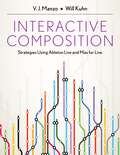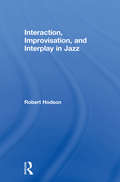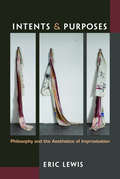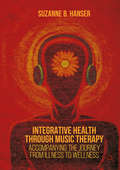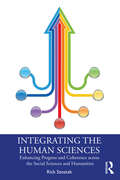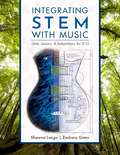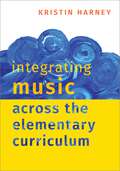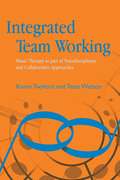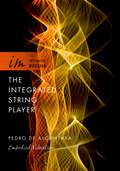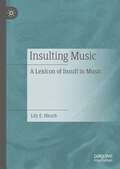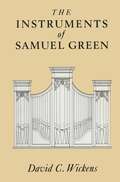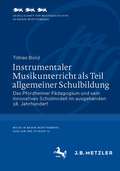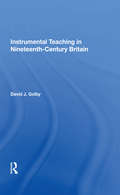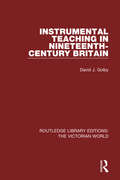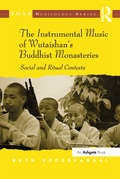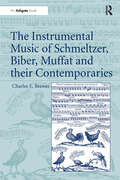- Table View
- List View
Interactive Composition: Strategies Using Ableton Live and Max for Live
by Will Kuhn V.J. ManzoInteractive Composition empowers readers with all of the practical skills and insights they need to compose and perform electronic popular music in a variety of popular styles. The book begins by introducing all of the tools involved in creating interactive compositions through the software Ableton Live and Max for Live. The following chapters then put the tools to use by both describing particular musical styles and also teaching readers how to compose and perform within these styles using the software. As readers progresses through the book, they will learn to use the software to facilitate their own unique compositional objectives. This book takes readers through all of the steps in designing interactive music compositions. It is geared toward both beginners as well as intermediate and advanced readers, and so readers with even little experience working with digital audio software will quickly learn how to design powerful systems that facilitate their unique compositional ideas. A particular feature of this book is that it discusses the historical context of several electronic music styles used by DJs, electronic musicians, and other artists, and then describes, using software, the technical process used in the composition and performance of these styles. Each chapter leads readers to create an original composition in a given style and also discusses the techniques that can be used to perform the piece in an idiomatic fashion.
Interactive Composition: Strategies Using Ableton Live and Max for Live
by V.J. Manzo Will KuhnInteractive Composition empowers readers with all of the practical skills and insights they need to compose and perform electronic popular music in a variety of popular styles. The book begins by introducing all of the tools involved in creating interactive compositions through the software Ableton Live and Max for Live. The following chapters then put the tools to use by both describing particular musical styles and also teaching readers how to compose and perform within these styles using the software. As readers progresses through the book, they will learn to use the software to facilitate their own unique compositional objectives. This book takes readers through all of the steps in designing interactive music compositions. It is geared toward both beginners as well as intermediate and advanced readers, and so readers with even little experience working with digital audio software will quickly learn how to design powerful systems that facilitate their unique compositional ideas. A particular feature of this book is that it discusses the historical context of several electronic music styles used by DJs, electronic musicians, and other artists, and then describes, using software, the technical process used in the composition and performance of these styles. Each chapter leads readers to create an original composition in a given style and also discusses the techniques that can be used to perform the piece in an idiomatic fashion.
Interaction, Improvisation, and Interplay in Jazz
by Robert HodsonInteraction, Improvisation, and Interplay in Jazz Performance offers a new and exciting way to listen to and understand jazz. When describing a performance, most jazz writers focus on the improvised lines of the soloist and their underlying harmonic progressions. This approach overlooks the basic fact that when you listen to jazz, you almost never hear a single line, but rather a musical fabric woven by several musicians in real time. While it is often pragmatic to single out an individual solo line, it is important to remember that an improvised solo is but one thread in that fabric; and it is a thread supported by, responded to, and responsive of the parts being played by the other musicians in the group. Interaction, Improvisation, and Interplay in Jazz Performance explores the process of player interaction in jazz, and the role this interaction plays in creating improvised music, including: jazz improvisation through theory and analysis musical roles, behaviours and relationships harmony, interaction and performance Interaction, Improvisation, and Interplay in Jazz Performance will appeal to students of jazz history, composition, and performance, as well as to the general jazz audience.
Interaction, Improvisation, and Interplay in Jazz
by Robert HodsonInteraction, Improvisation, and Interplay in Jazz Performance offers a new and exciting way to listen to and understand jazz. When describing a performance, most jazz writers focus on the improvised lines of the soloist and their underlying harmonic progressions. This approach overlooks the basic fact that when you listen to jazz, you almost never hear a single line, but rather a musical fabric woven by several musicians in real time. While it is often pragmatic to single out an individual solo line, it is important to remember that an improvised solo is but one thread in that fabric; and it is a thread supported by, responded to, and responsive of the parts being played by the other musicians in the group. Interaction, Improvisation, and Interplay in Jazz Performance explores the process of player interaction in jazz, and the role this interaction plays in creating improvised music, including: jazz improvisation through theory and analysis musical roles, behaviours and relationships harmony, interaction and performance Interaction, Improvisation, and Interplay in Jazz Performance will appeal to students of jazz history, composition, and performance, as well as to the general jazz audience.
Intents and Purposes: Philosophy and the Aesthetics of Improvisation
by Eric LewisHow do we define improvised music? What is the relationship of highly improvised performances to the work they are performances of? How do we decide what are the important parts of an improvised musical work? In Intents and Purposes, Eric Lewis uses a series of case studies to challenge assumptions about what defines a musical work and musical performance, seeking to go beyond philosophical and aesthetic templates from Western classical music to foreground the distinctive practices and aesthetics of jazz. Pushing aside the assumption that composition and improvisation are different (or even opposed) musical practices, Lewis’s philosophically informed approach revisits key topics in musical ontology, such as how to define the triangle of composer-performer-listener, and the status of live performances in relation to scores and recordings. Drawing on critical race theory, feminist theory, new musicology, sociology, cognitive science, and genre theory, Lewis opens up new questions about agency in performance, as well as new ways of considering the historical relationships between improvisational practices with roots in different cultural frameworks. By showing how jazz can be both art, idea, and action all at the same time, Lewis offers a new way of seeing any improvised musical performance in a new culturally and aesthetically rich context.
Integrative Health through Music Therapy: Accompanying the Journey from Illness to Wellness
by Suzanne B. HanserRecent music therapy advances and evidence-based practices have earned respect within the medical sciences and garnered popularity amongst users and practitioners. While integrative medicine treats the whole patient with ayurvedic and allopathic medicine, music therapy provides a safe and effective way of managing stress, pain, unpleasant symptoms, response to illness, and treatment side effects, and has been proven to enhance patients’ quality of life and general wellbeing. Exploring the ways in which these methods have been practised throughout history, the author takes readers on a journey from illness to wellness, and shows how this can be guided through music. The book instructs music therapists and other practitioners in the use of specific techniques, providing examples of clinical applications. It includes activities that prepare a music therapist physically, emotionally and musically for this journey with another, and provides case studies to explore the difficulties that might arise.
Integrating the Human Sciences: Enhancing Progress and Coherence across the Social Sciences and Humanities
by Rick SzostakWhat if we recognized that the human sciences collectively investigate a few dozen key phenomena that interact with each other? Can we imagine a human science that would seek to stitch its understandings of this system of phenomena into a coherent whole? If so, what would that look like? This book argues that we are unlikely to develop one unified "theory of everything." Our collective understanding must then be a "map" of the myriad relationships within this large – but finite and manageable – system, coupled with detailed understandings of each causal link and of important subsystems. The book outlines such a map and shows that the pursuit of coherence – and a more successful human science enterprise – requires integration, recognizing the strengths and weaknesses of different methods and theory types, and the pursuit of terminological and presentational clarity. It explores how these inter-connected goals can be achieved in research, teaching, library classification, public policy, and university administration. These suggestions are congruent with, and yet enhance, other projects for reform of the human sciences. This volume is aimed at any scholar or student who seeks to comprehend how what they study fits within a broader understanding.
Integrating the Human Sciences: Enhancing Progress and Coherence across the Social Sciences and Humanities
by Rick SzostakWhat if we recognized that the human sciences collectively investigate a few dozen key phenomena that interact with each other? Can we imagine a human science that would seek to stitch its understandings of this system of phenomena into a coherent whole? If so, what would that look like? This book argues that we are unlikely to develop one unified "theory of everything." Our collective understanding must then be a "map" of the myriad relationships within this large – but finite and manageable – system, coupled with detailed understandings of each causal link and of important subsystems. The book outlines such a map and shows that the pursuit of coherence – and a more successful human science enterprise – requires integration, recognizing the strengths and weaknesses of different methods and theory types, and the pursuit of terminological and presentational clarity. It explores how these inter-connected goals can be achieved in research, teaching, library classification, public policy, and university administration. These suggestions are congruent with, and yet enhance, other projects for reform of the human sciences. This volume is aimed at any scholar or student who seeks to comprehend how what they study fits within a broader understanding.
Integrating STEM with Music: Units, Lessons, and Adaptations for K-12
by Shawna Longo Zachary GatesThis practical resource for music educators provides 15 fully-developed and classroom-vetted instructional plans with assessments that are aligned to articulate learning from kindergarten through grade 12. With these instructional lessons and adaptations for K-12 music and STEM classes, pre-service educators, in-service educators, and administrators can better understand and immediately use tools for planning, assessing, and the practical integrating of STEM with Music. As authors Shawna Longo and Zachary Gates demonstrate, the arts bring creativity and innovation to the forefront in STEM learning. This book helps music teachers make natural connections between science, technology, engineering, math, and music. To do so, the book frames twenty-first century learning skills and career-ready practices so that the creativity and innovation necessary to succeed in STEM content areas and careers can be directly addressed by the educational community. The connection that the book makes between STEM content areas and music stimulates inquiry, dialogue, and critical thinking.
Integrating STEM with Music: Units, Lessons, and Adaptations for K-12
by Shawna Longo Zachary GatesThis practical resource for music educators provides 15 fully-developed and classroom-vetted instructional plans with assessments that are aligned to articulate learning from kindergarten through grade 12. With these instructional lessons and adaptations for K-12 music and STEM classes, pre-service educators, in-service educators, and administrators can better understand and immediately use tools for planning, assessing, and the practical integrating of STEM with Music. As authors Shawna Longo and Zachary Gates demonstrate, the arts bring creativity and innovation to the forefront in STEM learning. This book helps music teachers make natural connections between science, technology, engineering, math, and music. To do so, the book frames twenty-first century learning skills and career-ready practices so that the creativity and innovation necessary to succeed in STEM content areas and careers can be directly addressed by the educational community. The connection that the book makes between STEM content areas and music stimulates inquiry, dialogue, and critical thinking.
Integrating Music Across the Elementary Curriculum
by Kristin HarneyThis book is designed to support K-5 classroom teachers as they integrate music throughout the elementary curriculum. It contains detailed, practical ideas and examples, including full lesson plans and over 100 teaching ideas and strategies for integrating music with visual art, language arts, social studies, science, and mathematics. Following an overview of the interdisciplinary approach, the remaining chapters explore connections between music and other areas of the elementary curriculum. Each chapter also includes a section addressing national standards with tables showing the specific standards that are included in each lesson and activity. This text utilizes the most recent National Core Arts Standards (2015) as well as the most recent standards in mathematics, science, social studies, and language arts. All the lessons in this book are designed to be fully taught by classroom teachers; the content is accessible to those who lack formal music training, yet is solidly rooted in research and best practices. While classroom teachers can teach these lessons on their own, this book may facilitate partnerships and collaboration between classroom teachers and music specialists. All the lessons and activities included in this text have been reviewed by practicing teachers and most have been field tested in elementary classrooms. Throughout the book, there is an emphasis on interdisciplinary lessons that demonstrate valid connections between disciplines while maintaining the integrity of each discipline involved, including a teacher-tested model that allows teachers to successfully create their own interdisciplinary lessons.
Integrating Music Across the Elementary Curriculum
by Kristin HarneyThis book is designed to support K-5 classroom teachers as they integrate music throughout the elementary curriculum. It contains detailed, practical ideas and examples, including full lesson plans and over 100 teaching ideas and strategies for integrating music with visual art, language arts, social studies, science, and mathematics. Following an overview of the interdisciplinary approach, the remaining chapters explore connections between music and other areas of the elementary curriculum. Each chapter also includes a section addressing national standards with tables showing the specific standards that are included in each lesson and activity. This text utilizes the most recent National Core Arts Standards (2015) as well as the most recent standards in mathematics, science, social studies, and language arts. All the lessons in this book are designed to be fully taught by classroom teachers; the content is accessible to those who lack formal music training, yet is solidly rooted in research and best practices. While classroom teachers can teach these lessons on their own, this book may facilitate partnerships and collaboration between classroom teachers and music specialists. All the lessons and activities included in this text have been reviewed by practicing teachers and most have been field tested in elementary classrooms. Throughout the book, there is an emphasis on interdisciplinary lessons that demonstrate valid connections between disciplines while maintaining the integrity of each discipline involved, including a teacher-tested model that allows teachers to successfully create their own interdisciplinary lessons.
Integrated Team Working: Music Therapy as part of Transdisciplinary and Collaborative Approaches (PDF)
by Alison Barrington Ann Sloboda Ann Woodward Claire Miller Claire Molyneux Jackie Lindeck Julie Sutton Karen Twyford Maria Radoje Nicky O'Neill Paula Hedderly Rachel Darnley-Smith Rachel Millman Rebecca O'Connor Roseanne Tyas Sally Watson Tessa Watson Wendy MageeIntegrated Team Working describes collaborative multidisciplinary approaches and demonstrates that they can be valuable methods of music therapy intervention. The authors explain the development of the music therapist's role within the multidisciplinary team and discuss the prevalence of collaborative partnerships between UK music therapists and other professionals such as occupational therapists, speech and language therapists, psychologists, physiotherapists and other arts therapists. They examine the rationale, purpose and application of collaborative approaches and explore how and why music therapists adopt these approaches at differing levels. The book includes case studies from a variety of clinical settings, which illustrate the creative and innovative approaches used in transdisciplinary work in the evolving discipline of music therapy. This theoretical and practical guide offers useful advice for music therapy students and professionals who wish to employ collaborative approaches. It will also be helpful for other professionals who are considering or already working together with music therapists.
INTEGRATED STRING PLAYER TIM C: Embodied Vibration (The Integrated Musician)
by Pedro de AlcantaraPedro de Alcantara's The Integrated String Player: Embodied Vibration is a practical guide for all string players: violinists and violists, cellists and bassists, but also gamba players and anyone who makes music drawing a bow across a string. Dozens of exercises, supported by a dedicated website with 80 video clips, cover all the basics of string playing, including left-hand articulation, vibrato, changes of position, double-stopping, sound production, string crossings, and many other techniques. Each exercise, however simple or complex, can become a meditation with the goal of integrating the musical, technical, and metaphysical aspects of a player's practice. Part I is devoted to the fundamentals of coordination, rhythm, and listening in depth. Part II focuses on the left hand, with an emphasis on healthy gestures that are charged with musicality and meaning. Part III covers the bowing arm, exploring innovative concepts such as expressive gesticulation, mechanical intelligence, and the use of the bow as the player's voice, both literally and symbolically. Part IV covers the integration of analytical thought and sensorial practice, providing an extensive study of the harmonic series, the circle of fifths, Tartini tones, and many other sonic aspects that are essential to a string player's musical freedom. In addition, the conversational, linguistic, compositional, and improvisatory dimensions of string playing are discussed and supported by multiple practical exercises. The Integrated String Player is addressed to players of all abilities and from all aesthetic backgrounds: students and professionals, teachers and performers, classically trained musicians and jazz players, chamber-music players and orchestral players.
The Integrated String Player: Embodied Vibration (The Integrated Musician)
by Pedro de AlcantaraPedro de Alcantara's The Integrated String Player: Embodied Vibration is a practical guide for all string players: violinists and violists, cellists and bassists, but also gamba players and anyone who makes music drawing a bow across a string. Dozens of exercises, supported by a dedicated website with 80 video clips, cover all the basics of string playing, including left-hand articulation, vibrato, changes of position, double-stopping, sound production, string crossings, and many other techniques. Each exercise, however simple or complex, can become a meditation with the goal of integrating the musical, technical, and metaphysical aspects of a player's practice. Part I is devoted to the fundamentals of coordination, rhythm, and listening in depth. Part II focuses on the left hand, with an emphasis on healthy gestures that are charged with musicality and meaning. Part III covers the bowing arm, exploring innovative concepts such as expressive gesticulation, mechanical intelligence, and the use of the bow as the player's voice, both literally and symbolically. Part IV covers the integration of analytical thought and sensorial practice, providing an extensive study of the harmonic series, the circle of fifths, Tartini tones, and many other sonic aspects that are essential to a string player's musical freedom. In addition, the conversational, linguistic, compositional, and improvisatory dimensions of string playing are discussed and supported by multiple practical exercises. The Integrated String Player is addressed to players of all abilities and from all aesthetic backgrounds: students and professionals, teachers and performers, classically trained musicians and jazz players, chamber-music players and orchestral players.
Insulting Music: A Lexicon of Insult in Music
by Lily E. HirschInsulting Music explores insult in and around music and demonstrates that insult is a key dimension of Western musical experience and practice. There is insult in the music we hear, how we express our musical preferences, as well as our reactions to settings and sites of music and music making. More than that, when music and insult overlap, the effects can both promote social justice or undermine it, foster connection or break it apart. The coming together of music and insult shapes our sense of self and view of other people, underlining and constructing difference, often in terms of race and gender. In the last decade, music’s power dynamics have become an increasingly important concern for music scholars, critics, and fans. Studying musicians such as Frank Zappa, Nickleback, Taylor Swift, and the Insane Clown Posse, and musical phenomena such as musician jokes, the use of music to torture people, and the playing of music in restaurants, this book shows the various and contradictory ways insults are used to negotiate those existing dynamics in and around music.
The Instruments of Samuel Green (Macmillan Organ Studies)
by David C WickensA detailed survey and catalogue of the life and works of the English organ builder Samuel Green (1740-1796). A short biographical survey traces Green's career to the period when he established himself as the foremost English builder of organs of the late 18th century. This is followed by a detailed account of the design and constructional method of his chamber instruments and church organs. A chronological survey of his entire output gives the specification and history of each instrument and a reassessment of earlier sources. The text is illustrated with photographs and line drawings showing the characteristic features of Green's organ construction.
Instrumentaler Musikunterricht als Teil allgemeiner Schulbildung: Das Pforzheimer Pädagogium und sein innovatives Schulmodell im ausgehenden 18. Jahrhundert (Musik in Baden-Württemberg | Quellen und Studien #12)
by Tobias BonzIn Pforzheim bestand zwischen 1776 und 1804 ein am Pädagogium angeschlossener Musikzug, in dem Geige, Flöte und Ensemblespiel gelehrt wurden. Dieser frühe Vorläufer eines instrumentalpraktischen Musikunterrichts an allgemeinbildenden Schulen wird in diesem Buch als Teil von Schulreformen der Spätaufklärung herausgestellt: In Konsequenz der Aufklärung richteten sich die Schulen neu aus und entwickelten eine Pädagogik, welche die Musik und besonders deren praktische Ausübung als wichtigen Teil der schönen Wissenschaften und Künste fest in ihrem Bildungskanon verankerte. Anhand des Pforzheimer Beispiels wird die Legitimation, die strukturelle Integration sowie die methodisch-didaktische Ausgestaltung des damaligen schulischen Instrumentalunterrichts analysiert, woraus sich Impulse und Argumente für den heutigen musikpädagogischen Diskurs ergeben.
Instrumental Teaching in Nineteenth-Century Britain
by David GolbyIt is a truth widely acknowledged that, while part of a uniquely diverse and vibrant musical environment, the achievements of home-grown British instrumentalists in the nineteenth century gave little cause for national pride. Drawing together information from a wide variety of primary and secondary sources, in particular treatises and tutors, David Golby demonstrates that while Britain produced many fewer instrumental virtuosi than its foreign neighbours, there developed a more serious and widespread interest in the cultivation of music throughout the nineteenth century. Taking a predominantly historical approach, the book moves from a discussion of general developments and issues to a detailed examination of violin pedagogy, method and content which is used as a guide to society's influence on cultural trends and informs the discussion of other instruments and institutional training that follows. In the first study of its kind Dr Golby examines in depth the inextricable links between trends in society, education and levels of achievement. He also extends his study beyond professional and 'art' music to incorporate the hugely significant amateur and 'popular' spheres. To provide a contextual framework for the study, the book includes a chronology of developments in 19th-century British music education, and a particularly useful feature for future researchers in this field is a representative chronology of principal British instrumental treatises 1780-1900 that features over 700 items.
Instrumental Teaching in Nineteenth-Century Britain (Routledge Library Editions: The Victorian World)
by David GolbyFirst published in 2004, this book demonstrates that while Britain produced many fewer instrumental virtuosi than its foreign neighbours, there developed a more serious and widespread interest in the cultivation of music throughout the nineteenth century. Taking a predominantly historical approach, the book moves from a discussion of general developments and issues to a detailed examination of violin pedagogy, method and content, which indicates society’s influence on cultural trends and informs the discussion of other instruments and institutional training that follows. In the first study of its kind, it examines in depth the inextricable links between trends in society, education and levels of achievement. It also extends beyond profession and ‘art’ music to amateur and ‘popular’ spheres. A useful chronology of developments in nineteenth-century British music education is also included. This book will be of interest to those studying the history of instrumental teaching and Victorian music.
Instrumental Teaching in Nineteenth-Century Britain (Routledge Library Editions: The Victorian World)
by David GolbyFirst published in 2004, this book demonstrates that while Britain produced many fewer instrumental virtuosi than its foreign neighbours, there developed a more serious and widespread interest in the cultivation of music throughout the nineteenth century. Taking a predominantly historical approach, the book moves from a discussion of general developments and issues to a detailed examination of violin pedagogy, method and content, which indicates society’s influence on cultural trends and informs the discussion of other instruments and institutional training that follows. In the first study of its kind, it examines in depth the inextricable links between trends in society, education and levels of achievement. It also extends beyond profession and ‘art’ music to amateur and ‘popular’ spheres. A useful chronology of developments in nineteenth-century British music education is also included. This book will be of interest to those studying the history of instrumental teaching and Victorian music.
Instrumental Teaching in Nineteenth-Century Britain (Music In Nineteenth-century Britain Ser.)
by David GolbyIt is a truth widely acknowledged that, while part of a uniquely diverse and vibrant musical environment, the achievements of home-grown British instrumentalists in the nineteenth century gave little cause for national pride. Drawing together information from a wide variety of primary and secondary sources, in particular treatises and tutors, David Golby demonstrates that while Britain produced many fewer instrumental virtuosi than its foreign neighbours, there developed a more serious and widespread interest in the cultivation of music throughout the nineteenth century. Taking a predominantly historical approach, the book moves from a discussion of general developments and issues to a detailed examination of violin pedagogy, method and content which is used as a guide to society's influence on cultural trends and informs the discussion of other instruments and institutional training that follows. In the first study of its kind Dr Golby examines in depth the inextricable links between trends in society, education and levels of achievement. He also extends his study beyond professional and 'art' music to incorporate the hugely significant amateur and 'popular' spheres. To provide a contextual framework for the study, the book includes a chronology of developments in 19th-century British music education, and a particularly useful feature for future researchers in this field is a representative chronology of principal British instrumental treatises 1780-1900 that features over 700 items.
The Instrumental Music of Wutaishan's Buddhist Monasteries: Social and Ritual Contexts (SOAS Studies in Music)
by Beth SzczepanskiBeth Szczepanski examines how traditional and modern elements interact in the current practice, reception and functions of wind music, or shengguan, at monasteries in Wutaishan, one of China's four holy mountains of Buddhism. The book provides an invaluable insight into the political and economic history of Wutaishan and its music, as well as the instrumentation, notation, repertoires, transmission and ritual function of monastic music at Wutaishan, and how that music has adapted to China's current economic, political and religious climate. The book is based on extensive field research at Wutaishan from 2005 to 2007, including interviews with monks, nuns, pilgrims and tourists. The author learned to play the sheng mouth organ and guanzi double-reed pipe, and recorded dozens of performances of monastic and lay music. The first extensive examination of Wutaishan's music by a Western scholar, the book brings a new perspective to a topic long favored by Chinese musicologists. At the same time, the book provides the non-musical scholar with an engaging exploration of the historical, political, economic and cultural forces that shape musical and religious practices in China.
The Instrumental Music of Wutaishan's Buddhist Monasteries: Social and Ritual Contexts (SOAS Studies in Music)
by Beth SzczepanskiBeth Szczepanski examines how traditional and modern elements interact in the current practice, reception and functions of wind music, or shengguan, at monasteries in Wutaishan, one of China's four holy mountains of Buddhism. The book provides an invaluable insight into the political and economic history of Wutaishan and its music, as well as the instrumentation, notation, repertoires, transmission and ritual function of monastic music at Wutaishan, and how that music has adapted to China's current economic, political and religious climate. The book is based on extensive field research at Wutaishan from 2005 to 2007, including interviews with monks, nuns, pilgrims and tourists. The author learned to play the sheng mouth organ and guanzi double-reed pipe, and recorded dozens of performances of monastic and lay music. The first extensive examination of Wutaishan's music by a Western scholar, the book brings a new perspective to a topic long favored by Chinese musicologists. At the same time, the book provides the non-musical scholar with an engaging exploration of the historical, political, economic and cultural forces that shape musical and religious practices in China.
The Instrumental Music of Schmeltzer, Biber, Muffat and their Contemporaries
by Charles E. BrewerBased on primary sources, many of which have never been published or examined in detail, this book examines the music of the late seventeenth-century composers, Biber, Schmeltzer and Muffat, and the compositions preserved in the extensive Moravian archives in Kromeriz. These works have never before been fully examined in the cultural and conceptual contexts of their time. Charles E. Brewer sets these composers and their music within a framework that first examines the basic Baroque concepts of instrumental style, and then provides a context for the specific works. The dances of Schmeltzer, for example, functioned both as incidental music in Viennese operas and as music for elaborate court pantomimes and balls. These same cultural practices also account for some of Biber's most programmatic music, which accompanied similar entertainments in Kromeriz and Salzburg. The many sonatas by these composers have also been misunderstood by not being placed in a context where it was normal to be entertained in church and edified in court. Many of the works discussed here remain unpublished but have, in recent years, been recorded. This book enhances our understanding and appreciation of these recordings by providing an analysis of the context in which the works were first performed.
